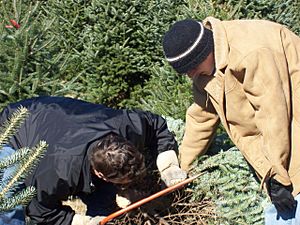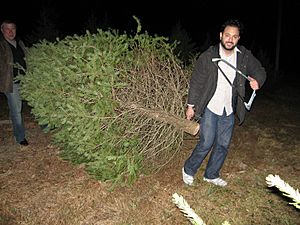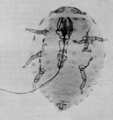Christmas tree cultivation facts for kids
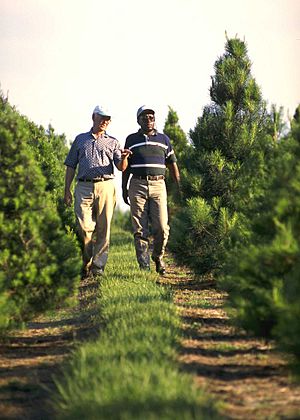
Christmas tree farming is a special kind of farming where people grow pine, spruce, and fir trees just to be used as Christmas trees.
The first Christmas tree farm started in 1901. But for a long time, most people still got their trees from wild forests. This changed in the 1930s and 1940s. At first, people thought you could only grow Christmas trees on poor land. But now, farmers know that good land helps grow the best trees. The best land for these farms is flat or gently sloped. It should also be clear of rocks and thick bushes.
Many types of pine and fir trees are grown for Christmas. In the United States, Douglas-fir, Scots pine, and Fraser fir are very popular. In the United Kingdom, Nordmann fir and Norway spruce sell well. Like all conifer trees, Christmas trees can get sick or be bothered by pests.
When it's time to sell the trees, farmers use different ways to harvest them. One popular way is "pick-your-own" farms. Here, families can walk around, choose their favorite tree, and cut it down themselves. Some farmers also grow trees in pots. These trees have their roots wrapped in soil. After Christmas, you can plant them in the ground. This way, they can be used again next year!
Contents
History of Christmas Tree Farms
Growing evergreen trees just for Christmas started in 1901. The first big farm had 25,000 Norway spruce trees near Trenton, New Jersey. But the idea of selling Christmas trees began even earlier, about 50 years before. A farmer from the Catskill Mountains brought trees to New York City to sell.
Even with these early efforts, most people still got their trees from wild forests until the 1930s and 1940s. After World War II, more trees were grown on special farms. By the 1950s, farmers started shaping and trimming trees. This helped them grow into the perfect Christmas tree shape that customers wanted.
The Christmas tree market grew a lot in the 1960s and 1970s. But after the late 1980s, prices for natural trees went down. Today, almost 98% of all real Christmas trees sold around the world come from tree farms.
How Christmas Trees Are Grown
Land and Weather for Trees
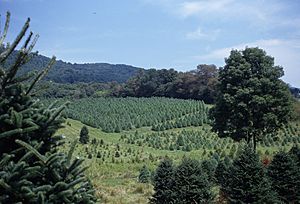
Christmas tree farms work best on land that is mostly flat and clear of things like big rocks. In the past, farmers often used land that wasn't good for other crops. But now, growing high-quality trees is important. So, farmers look for better land. Some trees, like the Fraser fir, cannot grow well on poor land.
Flat or gently sloped land is better than steep hills. Steep land can lose its soil easily and have uneven soil quality. Big rocks, fences, or thick bushes are also not good. They make it hard to plant and care for the trees.
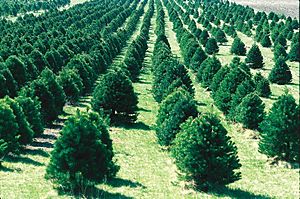
Just like any other plant, Christmas trees need certain nutrients to grow strong. They get some important elements like hydrogen, carbon, and oxygen from the air and water. Other nutrients, like nitrogen and potassium, come from the soil. If the soil doesn't have enough of these, farmers add special plant food called fertilizers.
The soil's pH (how acidic or basic it is) and how well water drains are also important. Different trees like different soils. Pine trees often prefer sandy soil. White spruce and fir trees, like Douglas fir, like finer soils with more clay. No matter the tree type, the land must drain water well. If water sits too long, the trees won't grow.
Weather also plays a big part in how well a Christmas tree farm does. Very cold winters or very hot, dry summers can harm the trees. Early snow can make it hard or impossible to cut and ship the trees.
Work and Tools for Farmers
Growing Christmas trees takes a lot of hard work. Before planting, farmers might need to use a bulldozer to clear big trees or rocks. If there are many weeds, the soil might be tilled (turned over). This helps remove any leftover plants. Farmers often use special sprays called herbicides to control weeds before planting. They also add fertilizers to the soil. All this work before planting helps the trees grow well.
After the small tree seedlings are in the ground, the work continues. Farmers must watch for pests (like insects) and diseases. They also need to keep weeds from growing too much. Many pine and fir trees need to be pruned and shaped. This usually happens two to four years after planting. This helps them get that classic Christmas tree shape. If trees are not pruned, they can have big gaps and might not sell well. Some pine trees, like the Scots pine, can turn yellow in winter. Farmers sometimes use a green dye or paint to make them look good.
The cost of equipment for a Christmas tree farm can be very different. Common tools include sprayers for insect control, tractors, and shaping shears. Machines that plant trees can cost about US$4,000. They are not a must-have, but they save a lot of work. Farmers buy young trees (seedlings) from nurseries. One farmer in Oregon bought 1,000 seedlings for US$200–300. He sold his full-grown trees for about $20 each. After all costs, he made about $2–3 profit per tree.
Types of Christmas Trees
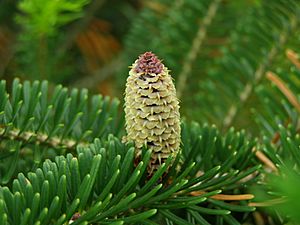
In North America, some of the most popular Christmas trees are Scots pine, Douglas fir, noble fir, balsam fir, Fraser fir, Virginia pine, and eastern white pine. But other types are grown too. For example, in Alabama, farmers grow eastern white pine, redcedar, Virginia pine, Leyland cypress, and Arizona cypress. In Florida, the sand pine and spruce pine are grown. About 20,000 of these trees are grown in Florida each year.
In Great Britain, Nordmann fir is very popular. This is because its needles stay on the tree well. Other popular trees in Britain are Norway spruce, Serbian spruce, and Scots pine. Scots pine is a bit rarer there. It has sharp needles that don't fall off easily.
The Pacific Northwest region of the U.S. is a big area for growing Christmas trees. Here, Douglas fir has always been the main type. Half of all trees grown in this region are Douglas firs. They usually take five to seven years to grow big enough to sell. Noble firs are also common and cost more than Douglas firs. Grand firs make up about 10% of the trees harvested there each year. Other types of trees are only a small part of the total harvest.
In North America, the Fraser fir, grown in the Appalachian Mountains of North Carolina, is sometimes called the "Cadillac of Christmas Trees." It's known as the "most popular and most valuable" Christmas tree. In the Southern United States, Virginia pine is a favorite. In Canada, white pine, white spruce, Scots pine, blue spruce, and Fraser fir are commonly grown. In Ontario, Scots pine has always been the most popular for both local and export markets. In Europe, Norway spruce is a popular choice.
Pests, Diseases, and Weeds
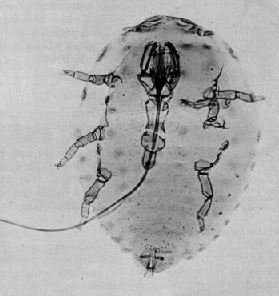
Many conifer trees grown for Christmas can be harmed by tiny insects. These include the balsam woolly adelgid, other adelgids, and aphids. New insect species that come from other places, like the pine shoot beetle and the gypsy moth, also threaten Christmas tree crops.
Christmas trees can also get sick from tiny fungi. These cause problems like root rot. In some western states, a disease called sudden oak death can also affect fir trees. Douglas fir trees are especially likely to get infections from plant diseases. These diseases can make Douglas fir trees impossible to sell as Christmas trees. This greatly affects the Christmas tree farming business.
Animals can also cause problems. Deer, gophers, and ground squirrels can damage tree roots and buds. Some birds, like the pine grosbeak, eat tree buds. They usually bother Scots pine, but also eastern white pine, red pine, and spruce trees.
Weeds, both small and woody, also compete with Christmas trees for water and nutrients. Farmers control weeds by mowing, using chemical sprays (herbicides), or turning over the soil.
Christmas Tree Quality
| Grade | What it means |
|---|---|
| U.S. Premium | Fresh, clean, healthy, very full, only one small problem allowed |
| U.S. No. 1 | Fresh, fairly clean, healthy, medium full, two small problems allowed |
| U.S. No. 2 | Fresh, fairly clean, healthy, not very full, three small problems allowed |
There are special quality grades for Christmas trees. In Ontario, Canada, these grades have been used since 1965 and are part of the law. In the United States, the grading system is not required by law. Many U.S. farmers make their own grading systems. These systems are often similar to the ones from the United States Department of Agriculture (USDA). The USDA's rules for Christmas tree grades started in 1989. They cover all types of evergreen trees sold as Christmas trees, whether they have been shaped or not.
How Trees Are Harvested
Christmas trees can be cut and sold in different ways. Some farms are called "choose-and-cut" or "pick-your-own" farms. Here, customers can walk through the farm, pick their tree, and cut it down themselves.
Wholesale farms sell many trees at once to stores. This takes more work for the farmer. They usually have to bale the trees (wrap them tightly), cut them, move them to a pick-up spot, and load them. All this work must be done in a very short time in November.
Some growers also dig up trees with their roots still in a ball of soil. They sell these as nursery trees or as live Christmas trees that can be replanted. This allows trees to be harvested earlier than the usual six to ten years it takes for a full-grown Christmas tree.
In the 1980s, larger farms started using helicopters to move cut trees. One farm in Oregon, which was 1,200 acres big, didn't have roads. So, they used helicopters to move up to 200,000 Christmas trees each year. Helicopters help trees get to the market faster. They cut the time from two weeks down to just three days.
Not all natural Christmas trees come from farms. In British Columbia, Canada, for example, most of the 900,000 trees cut for Christmas came from wild pine and fir forests. The British Columbia Ministry of Forests allows people to cut a free Christmas tree from public lands. But they need to get written permission first. In the United States, the United States Forest Service and the Bureau of Land Management offer permits. These allow people to cut individual trees on government land, mostly in National Forests.
Christmas Tree Farmers
The people who run Christmas tree farms can be full-time growers or part-time farmers. One farmer in Minnesota started planting trees in 1967. He gave trees away for free from his small 1-acre farm for ten years. Then, he started a business. Other farmers grow Christmas trees to earn extra money for retirement or college. Some farmers also work on farms that weren't originally set up for Christmas trees.
There are groups for Christmas tree growers in different countries. In the United Kingdom, the British Christmas Tree Growers Association is a group for farmers in Great Britain and Northern Ireland. The National Christmas Tree Association does a similar job in the United States.
Good and Bad for the Environment
In the United States, the National Christmas Tree Association (NCTA) says that real Christmas trees are better for the environment than fake ones. The NCTA says that every acre of Christmas trees makes enough oxygen for 18 people every day. Since there are 500,000 acres of trees grown in the U.S., that's enough oxygen for 9 million people daily!
The NCTA also says that tree farms help keep soil from washing away. They protect water supplies and provide homes for wildlife. Also, growing Christmas trees helps reduce carbon dioxide in the air. Carbon dioxide is a greenhouse gas that contributes to climate change. A study found that a real tree creates 3.1 kg of greenhouse gases. A fake tree makes 8.1 kg per year.
A report from 1998 said that people might choose fake trees more in the future. This is because of worries about how trees are grown and used. The report mentioned the use of fertilizers and pesticides. It also talked about concerns over how to get rid of trees after Christmas.
Some people worry about the use of pesticides on Christmas tree farms. Fir trees can get many pests and diseases. This means farmers sometimes use pesticides and other chemicals. One common chemical is glyphosate. Studies in North Carolina found traces of farm chemicals in homes and in the urine of tree farm workers. On average, a Christmas tree gets about a half ounce (14 grams) of pesticide during its lifetime.
The BBC's "Gardening" website said that buying Christmas trees directly from a farm is "the most environmentally friendly way." Real Christmas trees also have other good uses after the holidays. Researchers at the University of Nebraska said that old Christmas trees can be used as mulch (a protective layer for soil). If you have many trees, they can be piled up to stop soil erosion. Other good reuses include making homes for fish in ponds or bird feeders in backyards.
Christmas Tree Research
Since 2004, experts at Oregon State University (OSU) have been studying Christmas tree growing. In one department, Rick Fletcher studies Christmas tree genetics (how trees inherit traits), how to fertilize them, and how to manage diseases. Chad Landgren also focuses on tree genetics and disease.
In another OSU department, Mike Bondi researches tree fertilization, how much they grow, and genetics. He also studies how trees grow back naturally or with help. In the mid-1990s, these researchers worked on making better Christmas tree seeds. This led to more high-quality trees. Similar research has been done at New Mexico State University.
Other universities in places that grow Christmas trees also have research programs. North Carolina State University has staff who study all parts of tree growing. They have programs for tree genetics and help farmers with sustainable agriculture and pest control.
The Christmas Tree Research Center in Bible Hill, Nova Scotia, Canada, studies Balsam fir trees for Canadian growers.
Cultural Importance
In the United States, visiting Christmas tree farms has become a special holiday tradition for many families. Christmas tree farms have embraced this trend. At one farm in Minnesota, customers take photos with their trees. When they come back in later years, they can see their old photos on a "wall of memories." Some farms have served the same families for many generations. This makes the farm a part of each family's holiday traditions.
In 2006, New York state Agriculture Commissioner Patrick H. Brennan encouraged people to buy trees from local farms. He said,
It is a tradition in my family to visit our local tree farm and harvest our family's Christmas tree. It is a wonderful event for the whole family and if you don’t already do so, I encourage you to share this tradition with your family. –NY Agriculture Commissioner Patrick H. Brennan, 2006
Some tree farms offer more than just a chance to cut down a tree. They often have fun outdoor and holiday activities. These can include wagon rides, offering hot cocoa or cider, visits from Santa Claus, and holiday crafts. Many farms also invite schools to bring students for field trips. One farmer in Kansas said that things like a tough economy don't stop people from visiting Christmas tree farms. He believed that getting a tree from a farm is a tradition that almost nothing can stop.
Images for kids
- Christmas tree production in the United States
- Energy forestry
- Festive ecology
- Forestry
- Hanukkah bush
- Holiday tree
- New Year tree
- Rouse Simmons
- Silviculture
- Tree farm
See also
 In Spanish: Cultivo de árboles de Navidad para niños
In Spanish: Cultivo de árboles de Navidad para niños



